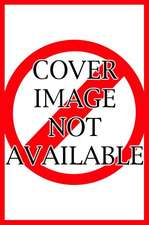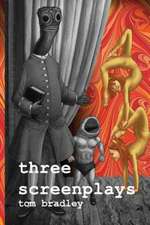Gold Diggers of 1933: Wisconsin / Warner Bros. Screenplays
Editat de Arthur Hove, Tino Balioen Limba Engleză Paperback – 14 apr 1980
This book contains the full shooting script of Erwin Gelsey and James Seymour, based on the Avery Hopwood play of 1919, as well as the lyrics to the five songs of the film. Arthur Hove's introduction outlines the story concept from its initial Broadway form, through the 1923 silent movie, the 1929 talkie, and including several post-1933 versions. The concept of the good-hearted chorus girl with a penchant for separating wealthy men from some of their money has long been popular with both theatre and movie audiences.
Hove tells much about the relationship between the story line and musical segments of the movie, about how far a writer can go before passing the baton to the director, and about how a film is actually put together.
The film is remembered for Berkeley's musical and visual extravaganza. In the opening number, "We're in the Money," his sumptuous corps de ballet, numbering fifty-four, appeared in costumes made of fifty-four thousand "silver" coins. Five silver dollars, twenty-eight feet in diameter formed the background for the chorus.
Preț: 214.03 lei
Nou
Puncte Express: 321
Preț estimativ în valută:
40.96€ • 44.48$ • 34.41£
40.96€ • 44.48$ • 34.41£
Carte tipărită la comandă
Livrare economică 23 aprilie-07 mai
Preluare comenzi: 021 569.72.76
Specificații
ISBN-13: 9780299080846
ISBN-10: 0299080846
Pagini: 192
Ilustrații: 20 illus.
Dimensiuni: 140 x 216 x 10 mm
Greutate: 0.24 kg
Ediția:1
Editura: University of Wisconsin Press
Colecția University of Wisconsin Press
Seria Wisconsin / Warner Bros. Screenplays
ISBN-10: 0299080846
Pagini: 192
Ilustrații: 20 illus.
Dimensiuni: 140 x 216 x 10 mm
Greutate: 0.24 kg
Ediția:1
Editura: University of Wisconsin Press
Colecția University of Wisconsin Press
Seria Wisconsin / Warner Bros. Screenplays
Notă biografică
Arthur Hove special assistant emeritus at the University of Wisconsin–Madison, served in a number of capacities during a long association with the University. He was assistant to the chancellor and director of public information from 1970 to 1989. From 1989 until his retirement in 1996 he was special assistant to the provost. In addition to his administrative responsibilities, he also taught courses in the School of Business, the School of Journalism and Mass Communication, and the Department of Art. He holds the Distinguished Alumnus Award presented by the Wisconsin Alumni Association and is the author of The University of Wisconsin: A Pictorial History (1991) and co-author, with Warrington Colescott, of Progressive Printmakers: Wisconsin Artists and the Print Renaissance (1999) both books published by the University of Wisconin Press.
Tino Balio, Professor in the Department of Communication Arts at the University of Wisconsin–Madison, is the author of United Artists: The Company Built by the Stars, United Artists: The Company That Changed the Film Industry, and the editor of The American Film Industry as well as the 22 volume Wisconsin/Warner Bros. Screenplay series, all published by the University of Wisconsin Press. He directed the Wisconsin Center for Film and Theatre Research from 1966 to 1882.
Tino Balio, Professor in the Department of Communication Arts at the University of Wisconsin–Madison, is the author of United Artists: The Company Built by the Stars, United Artists: The Company That Changed the Film Industry, and the editor of The American Film Industry as well as the 22 volume Wisconsin/Warner Bros. Screenplay series, all published by the University of Wisconsin Press. He directed the Wisconsin Center for Film and Theatre Research from 1966 to 1882.
Descriere
Gold Diggers of 1933, a lavish and glittering showcase for Busby Berkeley's musical production talent, was designed and produced as a Depression tonic. As Berkeley said, "In an era of breadlines, Depression, and wars, I tried to help people get away from all the misery . . . to turn their minds away to something else. I wanted to make people happy, if only for an hour.
This book contains the full shooting script of Erwin Gelsey and James Seymour, based on the Avery Hopwood play of 1919, as well as the lyrics to the five songs of the film. Arthur Hove's introduction outlines the story concept from its initial Broadway form, through the 1923 silent movie, the 1929 talkie, and including several post-1933 versions. The concept of the good-hearted chorus girl with a penchant for separating wealthy men from some of their money has long been popular with both theatre and movie audiences.
Hove tells much about the relationship between the story line and musical segments of the movie, about how far a writer can go before passing the baton to the director, and about how a film is actually put together.
The film is remembered for Berkeley's musical and visual extravaganza. In the opening number, "We're in the Money," his sumptuous corps de ballet, numbering fifty-four, appeared in costumes made of fifty-four thousand "silver" coins. Five silver dollars, twenty-eight feet in diameter formed the background for the chorus.
This book contains the full shooting script of Erwin Gelsey and James Seymour, based on the Avery Hopwood play of 1919, as well as the lyrics to the five songs of the film. Arthur Hove's introduction outlines the story concept from its initial Broadway form, through the 1923 silent movie, the 1929 talkie, and including several post-1933 versions. The concept of the good-hearted chorus girl with a penchant for separating wealthy men from some of their money has long been popular with both theatre and movie audiences.
Hove tells much about the relationship between the story line and musical segments of the movie, about how far a writer can go before passing the baton to the director, and about how a film is actually put together.
The film is remembered for Berkeley's musical and visual extravaganza. In the opening number, "We're in the Money," his sumptuous corps de ballet, numbering fifty-four, appeared in costumes made of fifty-four thousand "silver" coins. Five silver dollars, twenty-eight feet in diameter formed the background for the chorus.

































